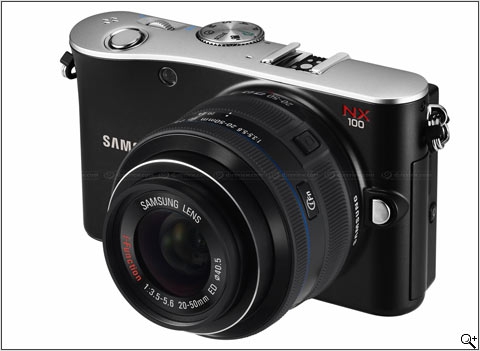Tuesday, September 14, 2010
Samsung Announces NX100 and Two Lenses; Previewed by Digital Photography Review
Posted by Lee Yuan Sheng in "Digital Home Hardware & Accessories" @ 07:24 AM
"Samsung has announced the addition of the NX100 to its NX series of mirrorless interchangeable lens cameras. It features the same 14.6Mp sensor and 3.0" OLED screen as the NX10, which are built into a flat, 'compact camera style' body. It also offers the i-Function feature that allows the use of the focus ring to control various camera functions when using compatible lenses. To complement this feature the company has launched two lenses with i-Fn buttons - the 20-50mm F3.5-5.6 ED kit zoom and 20mm F2.8 pancake lens."

Today's a big day, as three manufacturers decided that somehow Tuesday is a good day for announcements. The most interesting of the lot is Samsung's GF1/Pen competitor, the NX100. Thanks to Samsung's useless Press Release site, I have no images for you dear readers, save for a nicely watermarked image from DPReview (honestly, why they watermark PRESS IMAGES is beyond me).
The NX100 is an interchangeable lens compact using Samsung's own NX mount with APS-C sized sensors, in this case, a 14 megapixel Samsung development. Highlights include a 3" AMOLED display, 720p video, two command dials, and the ability to use i_Function lense. These lenses have an extra button on them, which when pressed, will allow the focus ring to perform other functions; kind of like the Canon S90/S95's customisable front command ring. The lenses have icons on them to show what kind of lenses they are; portrait icon for portrait lenses, and so on. The lenses communicate with the camera depending on the focal length, and will set the appropriate scene mode. Looks like Minolta's card system from the early 1990s revived, but placed in lenses instead of cards.
The two new lenses that debut are the 20-50/3.5-5.6 compact zoom, which collapses like many of the Olympus Pen lenses, and the 20/2.8 pancake lens. This gives Samsung about three kit zooms; two versions of the 18-55 (with and without stabilisation), and this 20-50. Samsung's lens lineup is rather pedestrian at this point, which is not good for a new system looking to attract users in a crowded market with many entrenched players.












